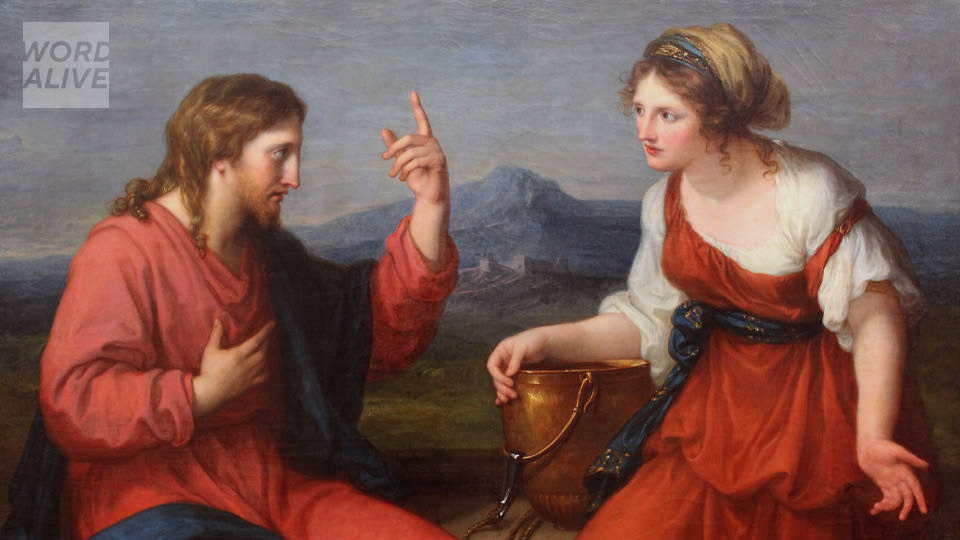



Jesus and the woman of Samaria | Word Alive
Josephine Lombardi
Friday, March 13, 2020

Detail of Christ and the Samaritan Woman at the Well by Angelica Kauffman (Source: Wikimedia Commons)

Jesus and the woman of Samaria
A reflection for the Third Sunday of Lent, Year A
by Josephine Lombardi
This Sunday’s reading from the Gospel of John presents the encounter of the Samaritan woman, known as St. Photina, with Jesus at Jacob’s well. This account reveals the power of encounter, invitation, transformation, and evangelization. It is a story of accompaniment, showing how Jesus’ fearless and relentless approach seeks the lost and invites them to new life. He invites us to go into unknown territory, where there is pain, isolation, and vulnerability, bringing hope and renewal. Jesus shows us how pastoral care is part of the Church’s evangelizing mission, modeling for us what responsible accompaniment looks like. This account is loaded with insights into the human condition, showing great attention to detail, using the power of signs and symbols. Indeed, the grace is in the details, and by considering even just a few of them, we can come to a better understanding of the profound meaning embedded in this story. Samaria: Jesus’ choice to travel through Samaria is interesting because Jews did not pass through Samaritan territory on their way from Judea to Galilee. They would have taken another route. Samaritans were descendants of Jews and Assyrians who had intermingled during times of conquest and exile. Jews, who did not compromise their beliefs during this time of transition, rejected them, avoiding all contact with them. Jesus models a new way of dealing with one’s neighbour by passing through Samaria. He shows us how to be fearless, abandoning judgment and going straight to where there is vulnerability and pain. We are not to talk around the vulnerable, care for them at a distance, or project our own ideas of their lived reality onto them. Instead, we are to be direct with our approach, leaving no one behind. Jacob’s Well: Jacob was the son of Isaac, who was the son of Abraham, and it is at this well, according to the book of Genesis, that Jacob meets his future wife, Rachel. This renders the well symbolic of courtship. It is here, in this place, that Jesus, the Bridegroom, thirsts for water but brings no jug. Living Water: Isaiah (12:3) prophesied “with joy” we “will draw water from the wells of salvation.” Jesus tells the woman that if she only knew who he was, she would be asking him for the gift of living water, water that quenches thirst forever. This water “will become…a spring of water gushing up to eternal life.” Jesus is revealing that he is the source of salvation, the source of our restoration, and the end of our search for fulfillment. Six Relationships: With his infused knowledge, Jesus knows that the woman has had five husbands and the one she has now is not her husband. No doubt, these relationships left her thirsting for more, more than any one of these men could give. Indeed, she shows up at noon, or the sixth hour, to draw water, possibly avoiding the other women out of fear of judgement. In sacred numerology, the number six is symbolic of imperfection. Jesus represents the seventh man she encounters, representing wholeness and perfection. Jesus reveals the truth of her existence to her and presents himself as living water, the healing she desires. She leaves the jar behind: As soon as the Samaritan woman discovers that Jesus is the Messiah, she leaves her water jar and goes back to the city to evangelize her people saying, “Come and see a man who told me everything I have ever done!” Transformed and healed by her encounter with Jesus, St. Photina went on to become a great evangelizer, called “Equal to the Apostles” because of her zeal for the Lord. Her thirst was satisfied, hence the abandonment of the water jar. Jesus approaches the vulnerable, identifies their need, and facilitates an encounter with mercy. His love transforms hearts, and the restored go out to proclaim the Good News with joy! In the Year of Mercy, Pope Francis declared that joy, serenity, and peace are the fruit of mercy, meaning an encounter with Jesus restores our internal balance. Do we know anyone who is in need of this healing encounter? Do we have the courage to approach and accompany them to a new life in Christ? Or, are we the ones in need of healing, but have gone into hiding, too afraid to approach God’s mercy out of fear of rejection and judgement? During this season of Lent, let us be mindful of the needs of those who are hiding, hurting due to past shame or regrets. St. Paul reminds us that nothing shall “separate us from the love of Christ” (Romans 8:35). These words should inspire us to seek out the lost and approach them with great mercy, revealing God’s tender love and satisfying their thirst for healing.The readings for the Third Sunday of Lent, Year A, are Exodus 17:3-7 Romans 5:1-2, 5-8 John 4:5-42
 Dr. Josephine Lombardi is Associate Professor of Pastoral and Systematic Theology, Professor of Field Education, and Director of Lay Formation for St. Augustine’s Seminary in Scarborough, Ontario. She has done media work in radio and television and has been an advisor to the Canadian Conference of Catholic Bishops in the area of doctrine and Catholic-Muslim relations.
Dr. Josephine Lombardi is Associate Professor of Pastoral and Systematic Theology, Professor of Field Education, and Director of Lay Formation for St. Augustine’s Seminary in Scarborough, Ontario. She has done media work in radio and television and has been an advisor to the Canadian Conference of Catholic Bishops in the area of doctrine and Catholic-Muslim relations.Related Articles:
<<
SUPPORT LABEL
$50
$100
$150
$250
OTHER AMOUNT
DONATE
Receive our newsletters
Stay Connected
Receive our newsletters

Stay Connected







